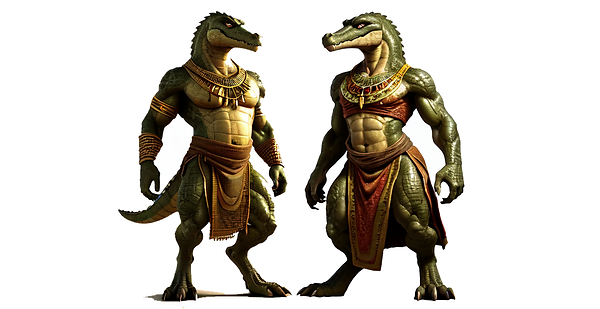SIAE Registration Protocol N° 2023/00696
Crocodiles
The Crocodile people can be generally compared to a blend of Xhosa Nguni society and members of Crocodylia biological order.
Crocodiles are one of the twelve races of anthropomorphic reptiles that populate Yanìs, and are grouped in the subgenus of Scaleds together with Monitors, Tortoises and Turtles.
Physically, they are quite tall and massive, with an average height between 8 and 8.5 feet, and a weight that can vary between 200 and 400 kg. Although they have a slightly comical appearance due to the large gap in size between their large torso and head, and their short limbs, this funny aspect immediately fades at the sight of their size. Their body is elongated and hydrodynamic, covered with large scales, which are usually dark in color on their back and light on their belly. Their head is almost triangular, with nostrils at the end of the jaw and protruding eyes, while their long tail is vertically flattened and therefore suitable for swimming. They reproduce through oviparity, with females laying several eggs in a muddy basin after fertilization occurs through sexual acts.
Among the Crocodile people, each family unit has its own village with crops and livestock, which is ruled by a householder. The wealth of a family is counted in cattle, with the addition of all mature children who, in their society, are a precious asset. This esteem for young adults comes from their traditional sequence of initiations. Starting from birth, in fact, a Crocodile goes through graduation stages that recognize its growth and assign it a place in the community. At an early age, as soon as they learn to walk and express themselves, Crocodiles must undergo an initiation called imbeleko to access community life. Later, during adolescence, a second ritual called umphumo leads them to access to studies. Then, at the end of their studies, the ritual towards mature age and independence from family, inkwenkwe. These rituals and ceremonies are sacred for the identity and legacy of the Crocodile people because all these rites provide a series of mortal fights in an arena, scheduled in groups and all against all, with males and females together: only the strongest and most fierce survive.
Despite their aggressive and threatening appearance, Crocodile people have been characterized by a remarkable openness towards other races. They are good traders and have established good relationships with the races they have come in contact with. Especially with their smaller cousins, Chameleons, with whom they live in a sort of social symbiosis, mixing territories, occupations, and soldiers, but without ever mixing or losing racial traditions. Contrary to what their predatory nature suggests, their most daily activities are river fishing and cattle farming, with rare cultivation, literate and magic studies, and social debates.
They speak Erpeton language, common to all Anthro reptile races, a harsh, hissing language, spoken mostly in the southern hemisphere of the planet (perhaps an Arabic gibberish).
Religiously they are mostly devoted to Kalaukeke (deity of battles and competition), Ekoari (deity of science and crafting), and Zundoey (deity of curses and oblivion), but they are still strongly linked to traditional Lohudonist and Druidic cults.
Their Ancestral Princes were Sangom and Igqirha, who taught their race the ancient and timeless art of stillness and invisibility. Combined with the pleasant custom of spending most of the morning basking together, both to warm up and to strengthen relationships, the art of stillness is fundamental for Crocodile people. Their warfare tactics are based on immobility; their espionage network is based on invisibility; their social relationships are based on their nature as passive predators.
